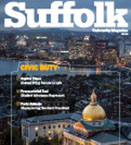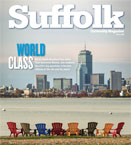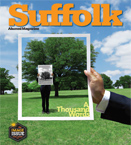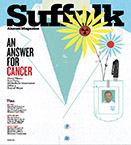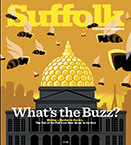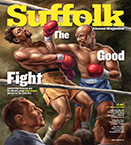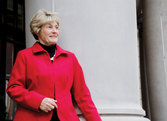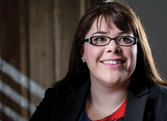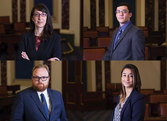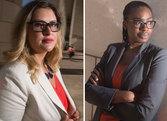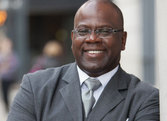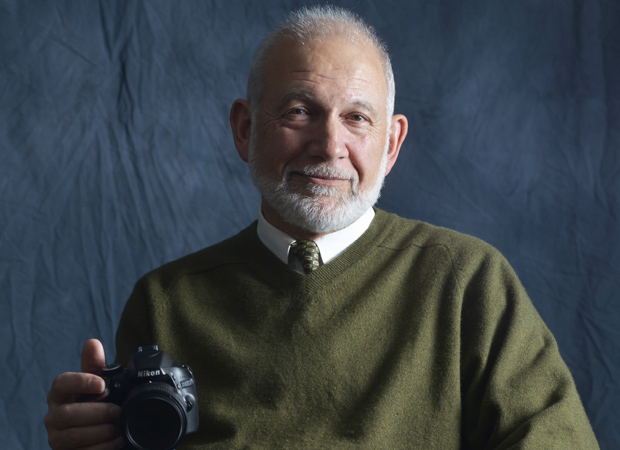
Photographic Memory
Instructor Ken Martin has a long history as Suffolk’s image maker
By Sam Tremont
Photographs line the corridors outside Ken Martin’s classroom: a breathtaking view of Vatican Square, a lively street scene at a gelateria in Tuscania, a study in shadows and light at a villa in Tivoli. Accomplished works like these are the product of trips from the Lens on Italy series, a partnership Martin initiated with the Lorenzo de Medici Institute in the medieval town of Tuscania. He has also travelled with students in search of photographic inspiration from as far away as Spain and Senegal and as close to home as the North End and Chinatown in Boston.
Returning from spring break this afternoon, he begins by handing out copies of a trade magazine and encouraging students to submit their work for publication and competitions. He remembers and inquires about every student’s vacation plans. They ask if he and his son went ice fishing over spring break. “I just got an e-mail about some summer work for you,” he tells one young woman.
The first order of business is a slide show. Students recognize photographs of Audrey Hepburn, Grace Kelly, Alfred Hitchcock, and Fidel Castro but when one has another famous name on the tip of his tongue, Martin, 62, deadpans, “You’re having a senior moment.” To a student from the Midwest, he notes that another subject, Ernest Hemingway, comes “from your part of the country.” Every photo comes with a story: an image of one of the fathers of photography, Louis-Jacques-Mandé Daguerre; works by Diane Arbus, Richard Avedon, Annie Leibovitz; a portrait by Yousuf Karsh, who was able to snatch the cigar from the mouth of his notoriously camera-averse subject, Winston Churchill. “Fortunate or otherwise, you have a history major for a teacher,” Martin shrugs.
Calli Ann Baylock BS ’14 sees the nod to the past as a plus. She did not know of Martin when she signed up for Lens on Spain: Photojournalism in Madrid last summer but “realized it was the best choice I made” and calls Martin “one of the most engaging, intelligent, liberal-minded, trusting, funny, ambitious, and kindest professors I know. He develops a connection with present and past-time news, events, or history and ties it with the role of photography in a journalistic form. It’s amazing!”
Martin asks his students to help set up lighting. When he excuses himself to get extra umbrellas from his office, they request candy and, sure enough, he returns with a stash. Working together, they transform the classroom into a makeshift studio in minutes, then alternate in the roles of model and photographer as Martin demonstrates how simple changes in lighting can completely alter the emotion and atmosphere of the same image.
Halfway through the three-hour class, he offers a break, but the conversation continues for another 15 minutes before he can get students to take it. Martin’s easy rapport and the tone of the class—purposeful, yet casual and familiar—suggest a long history of teaching. Yet neither teaching, history, nor even photography were a part of his parents’ game plan. Martin’s father, an electrician, and his mother, a bookkeeper, wanted him to become a dentist or a lawyer. Yet, he recalls, “As a child, I enjoyed using cameras that my dad owned, a Kodak Hawkeye and a Polaroid.” And as an undergraduate at College of the Holy Cross in Worcester, he majored in history and took classes in art history and fine art.
In 1981, Suffolk had a partnership with Action for Boston Community Development (ABCD) to teach disadvantaged youth about the journalism profession. Martin, who had began his career as a photojournalist, was among the professionals the chairman of the journalism department invited as a guest speaker. He became a photography instructor for two Suffolk projects: the ABCD collaboration and a journalism program for minority students before being asked to teach photojournalism. Martin then joined a photo agency, covering events like the visit to Boston by then South African President Nelson Mandela and became a freelance photographer for the Tab newspaper group outside Boston. In 1989, he became an adjunct professor for the Department of Communication and Journalism. In 2002, he added classes for NESAD students. After joining the Government Department for a class trip to Cuba, he was invited to teach a summer class in Dakar, Senegal. This class was the first of what would become a series of study-abroad opportunities. The rest is, well, history.
“My career has certainly not been a typical one for a teacher,” Martin confesses. “I did not plan to teach, but found myself interested in knowing that I could help others learn to do something very interesting and intellectually rewarding.”
More than three decades later, the rewards seem to cut both ways. As his student Baylock reflects, “I can constantly feel the love for the field of photography and for the world because of Ken.”
